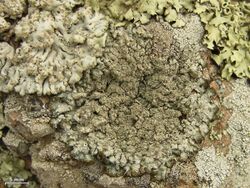Biology:Punctelia punctilla
| Punctelia punctilla | |
|---|---|

| |
| On Conejo Mountain, southern California | |
| Scientific classification | |
| Domain: | Eukaryota |
| Kingdom: | Fungi |
| Division: | Ascomycota |
| Class: | Lecanoromycetes |
| Order: | Lecanorales |
| Family: | Parmeliaceae |
| Genus: | Punctelia |
| Species: | P. punctilla
|
| Binomial name | |
| Punctelia punctilla (Hale) Krog (1982)
| |
| Synonyms | |
| |
Punctelia punctilla is a species of foliose lichen in the family Parmeliaceae. It is found in Africa, South America, and North America, where it grows on bark and on rocks. The main characteristics that distinguish Punctelia punctilla from other species of Punctelia are the presence of isidia on the thallus surface, a pale brown thallus undersurface, and the presence of lecanoric acid in the medulla.
Taxonomy
It was first formally described in 1977 as a new species by American lichenologist Mason Hale as Parmelia punctilla. The type specimen was collected by Ove Almborn in the Cathedral Peak area of South Africa , where it was found growing on a rock in Indumeni forest. The altitude of the type locality was 5,500 m (18,000 ft).[1] Hildur Krog transferred it to the genus Punctelia in 1982.[2]
In 1997, Mónica Adler proposed to synonymize the taxon Punctelia missouriensis with P. punctilla.[3] André Aptroot later rejected this proposal, suggesting sufficient morphological differences exist for P. missouriensis to warrant distinction as an independent species.[4]
Description
Punctelia punctilla has a light mineral grey foliose thallus with darker margins. It is tightly attached to its substrate. There are abundant pseudocyphellae on that thallus surface; they are white, rounded to elongated, and measure up to 0.5 mm. The isidia are dull and low, sometimes branched, and often originate in cracks or at the margins of the pseudocyphellae. The thallus undersurface is pale tan with darker margins. Rhizines are usually simple (i.e. unbranched) and more or less the same colour as the undersurface.[5]
Standard chemical spot tests can be used to help identify Punctelia punctilla. In the medulla, these results are K-, KC+ red, and C+ red. The last of these tests indicates the presence of lecanoric acid. The upper cortex contains atranorin, which results in a yellow K+ reaction.[5]
Species similar in appearance to Punctelia punctilla include Punctelia rudecta and Punctelia eganii, two North American endemics that are morphologically indistinguishable from each other.[6]
Habitat and distribution
Punctelia punctilla has been recorded growing on both bark and on rocks. First described from South Africa, it was later recorded from various locations in South America, including several provinces of Argentina (Mendoza,[7] Buenos Aires,[8] Santiago, Corrientes, Córdoba, and Río Negro), Brazil (São Paulo),[9] and Venezuela.[3] The lichen was first reported from the United States in 1989; the material was verified by Mason Hale. It was found growing on rocks at the base of a rocky outcrop in southern coastal California , in Point Mugu State Park; this area has a Mediterranean climate.[10] A herbarium specimen of Punctelia punctilla collected in Iowa was later assumed to be a misidentification.[11] The lichen has also been recorded from the Mexican state Baja California Sur.[5]
References
- ↑ Krog, Hildur; Swinscow, T.D.V. (1977). "The Parmelia borreri group in East Africa". Norwegian Journal of Botany 24 (3): 167–177.
- ↑ Krog, Hildur (1982). "Punctelia, a new lichen genus in the Parmeliaceae". Nordic Journal of Botany 2 (3): 287–292. doi:10.1111/j.1756-1051.1982.tb01191.x.
- ↑ 3.0 3.1 Adler, Mónica T. (1997). "Polymorphism of vegetative propagules in Punctelia punctilla (Parmeliaceae, Lecanorales), and the delimitation of the species". Mycotaxon 63: 57–70. http://www.cybertruffle.org.uk/cyberliber/59575/0063/0057.htm.
- ↑ Aptroot, André (2003). "A new perspective on the sorediate Punctelia (Parmeliaceae) species of North America". The Bryologist 106 (2): 317–319. doi:10.1639/0007-2745(2003)106[0317:ANPOTS2.0.CO;2].
- ↑ 5.0 5.1 5.2 Nash, T.H. III; Ryan, B.D.; Diederich, P.; Gries, C.; Bungartz, F. (2004). Lichen Flora of the Greater Sonoran Desert Region. 2. Tempe: Lichens Unlimited, Arizona State University. p. 432. ISBN 978-0-9716759-1-9.
- ↑ Hodkinson, Brendan P.; Lendemer, James C. (2011). "Punctelia eganii, a new species in the P. rudecta group with a novel secondary compound for the genus". Opuscula Philolichenum 9: 35–38. https://www.researchgate.net/publication/265155405.
- ↑ Ferraro, Lidia Itatí (1986). "Contribution to the study of Argentine Parmeliaceae. The genus Punctelia Krog and Flavopunctelia (Krog) Hale". Phytologia 61: 189–203. https://archive.org/details/biostor-167943.
- ↑ Osorio, H.S. (1987). "Contribution to the lichen flora of Argentina. XVI. Lichens from Sierra de la Ventata, Buenos Aires Province". Comunicaciones Botánicas del Museo de Historia Natural de Montevideo 4 (78): 1–11.
- ↑ Marcelli, Marcelo Pinto; Jungbluth, Patrícia; Elix, John A. (2009). "Four new species of Punctelia from São Paulo State, Brazil". Mycotaxon 109: 49–61. doi:10.5248/109.49.
- ↑ Reifner, R.E. (1989). "Punctelia punctilla (Hale) Krog, new to North America". Phytologia 67 (3): 254–257. https://www.biodiversitylibrary.org/page/13167947.
- ↑ Colbert, James T. (2011). "Current status of lichen diversity in Iowa". Journal of the Iowa Academy of Science 118 (1–4): 16–23.
Wikidata ☰ Q10646758 entry
 |

